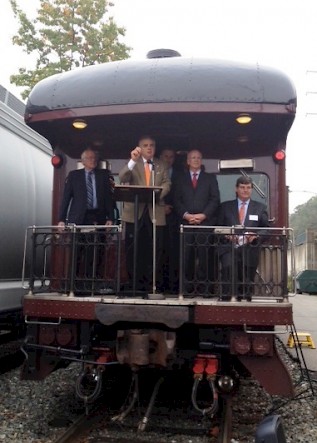Happening Now
Streetsblog "Keeping CNN Honest" -- You Can Too!
January 31, 2013
Written By Sean Jeans Gail

Take a moment and head over to the Midwest High Speed Rail Association, where you can join their campaign to demand that Anderson Cooper and his producers include the critical voices of high speed rail advocates and experts in future coverage.
Streetsblog’s Tanya Snyder has put together a comprehensive overview of the heated responses to CNN’s coverage of Recovery Act investment in the Vermonter service on Anderson Cooper 360. Schneider calls out reporter Drew Griffin for shoddy reporting, labeling the piece a “high-profile smear campaign.”
Some of Griffin’s mistakes result from failing to investigate his own claims. He dismissively describing how ridership would increase “somehow or another” if the state extended Vermonter service to Montréal. Snyder points out the Vermont Department of Transportation’s ridership projections found that an additional 78,000 to 120,000 riders would ride the train if it was extended to Montreal—nearly doubling the Vermonter’s current ridership. This builds on a point made in NARP’s response to the CNN piece, which is quoted in the Streetsblog post:
“It is absurd to imply that extending the train north to a major destination like Montréal would not produce a big ridership increase,” said Ross Capon, president of the National Association of Railroad Passengers, in a statement. [Federal Railroad Administrator Joseph] Szabo agrees: “Connecting in a major urban area like Montréal is significant and will exponentially grow ridership.”
Snyder also criticizes the general tone that pervades Griffin’s report that Vermont—which he calls “a state with no big cities and little congestion”—doesn’t merit federal support for trains:
Vermont is a perfectly natural place for rail, and the stimulus-funded improvements didn’t just save travelers time, they enhanced reliability and safety, too. Additionally, short line railroads will be able to haul heavier loads, taking more trucks off the highways and reducing congestion.
“It is likely, at least in the medium term, what I would classify as feeder service,” Szabo told me. “And that doesn’t mean it’s unimportant; in fact it’s a very important part of a network. But it’s about feeding those smaller communities in New England to the Northeast Corridor spine. It’s the level of connectivity that builds up synergy.”
Perhaps most importantly, Snyder provides some much needed context, almost entirely lacking from Griffin’s piece. She points out that the Vermont rail project accounted for .00006 percent of the Recovery Act as a whole, that the Vermont Agency of Transportation spent most of the $241.2 million in stimulus money it received for transportation on roads, and that the public is still waiting for Anderson Cooper and CNN—or any of the major cable news outlets—to investigate the $4.7 billion highway to nowhere in Alabama. After decades of federal policy where the “interstate system has been the beneficiary of more than $600 billion in public subsidies over and above what it rakes in from fuel taxes and tolls” and passenger trains have largely been ignored, rail has some catching up to do.
“Instead of complaining about this, they should be demanding more money spent,” Andy Kunz, president of the U.S. High-Speed Rail Association, told Streetsblog. “We’ve let rail fall apart in this country to such a state that there are a lot of basic repairs that are needed as well.”
“It’s the 21st century, we’re a top country in the world — why do we have such crappy rail service?” added Kunz. “It’s because we have never invested in rail in this country in 100 years.”
Snyder touches on many other aspects that Griffin gets wrong, and the piece is well worth a read.
Take a moment and head over to the Midwest High Speed Rail Association, where you can join their campaign to demand that Anderson Cooper and his producers include the critical voices of high speed rail advocates and experts in future coverage.
"On behalf of Amtrak’s onboard service staff, I want to thank the Rail Passengers Association for honoring their hard work with this award. The past couple years have indeed been difficult for Amtrak onboard service staff – coping with furloughs and job insecurity, adapting to changing protocols and services, not to mention the unfortunate events such as a tragic derailment and a fatal shooting. Nevertheless, our dedicated members at Amtrak have handled these hurdles with the care, attention and diligence for which they’re known. We thank Rail Passengers for their acknowledgement of our members’ hard work and, as always, look forward to seeing you on the rails."
Arthur Maratea, TCU/IAM National President
December 21, 2021, on the Association awarding its 2021 Golden Spike Award to the Frontline Amtrak Employees.
Comments